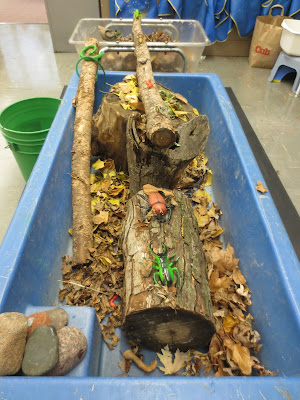To the natural elements, I added realistic plastic bugs, beetles, frogs, and snakes. The swamp was not complete, though, until I added the water.
Children approached the swamp in many different ways. Some children dug right in and others used the tools and implements to explore what was in the table.
The child below used tongs to handle a plastic brown snake she plucked out of the swamp.
The child below used tongs to handle a plastic brown snake she plucked out of the swamp.
The children lifted and held the logs and sticks much like they would have if they were to find them in the woods or on the beach. They got to feel their weight and texture.
One child experimented with balancing the logs and sticks on each other using the small table as a base.
Another child went so far as to take all the logs and sticks he could lift out of the table and pile them on the floor.
These logs and sticks were all different; they were not uniform in shape, size, or weight. Handling each one was a different exercise in strength and balance. There was also an aural component as the child dropped the stump onto the pile and hit the other pieces of wood on the pile.
Another child even tried to lift the second heaviest piece out of the table. It was a maple log that was quite heavy. Watch.
I was terribly conflicted when I made this video. I knew the log was heavy, too heavy for him to lift it safely out of the table. I was afraid he would loose control of it and it would drop on his leg or foot. On the other hand, I wanted to see if he could measure his own strength accurately. About midway through the video, the camera frame rose so I lost part of the action. That was because I needed to move in closer in case I would have to help. In the end, he decided for himself that the log was too heavy to lift. Instead, he rolled it over the stump to the other side of the table. In doing so, he took care that he never lost control of the log as it rolled. Not only did he demonstrate that he could measure his own strength, but he demonstrated that he could control this heavy log to the end of his operation.
Just think of all the things that could have happened in this episode. I ask you now: Was it too dangerous for the classroom? Was the risk worth the benefit?
 From the dangerous to the prosaic. Children scooped the water and leaves to make their own concoction. One group took to calling the swamp water "toilet water." You can imagine the silliness that ensued around this potty talk.
From the dangerous to the prosaic. Children scooped the water and leaves to make their own concoction. One group took to calling the swamp water "toilet water." You can imagine the silliness that ensued around this potty talk.
The plastic animals provided some children with an avenue for role playing. The child pictured below animated the family of frogs she collected on the stump.
In essence, this is a science table. Not the kind of science table
that is a display for the children to look at. No, this is a science
table for the children to actively engage in exploration. It is true that it is a contrived space that is a poor imitation of nature, but the children are still able to conduct personal investigations in the spirit of science in which content and process are inseparable.











No comments:
Post a Comment